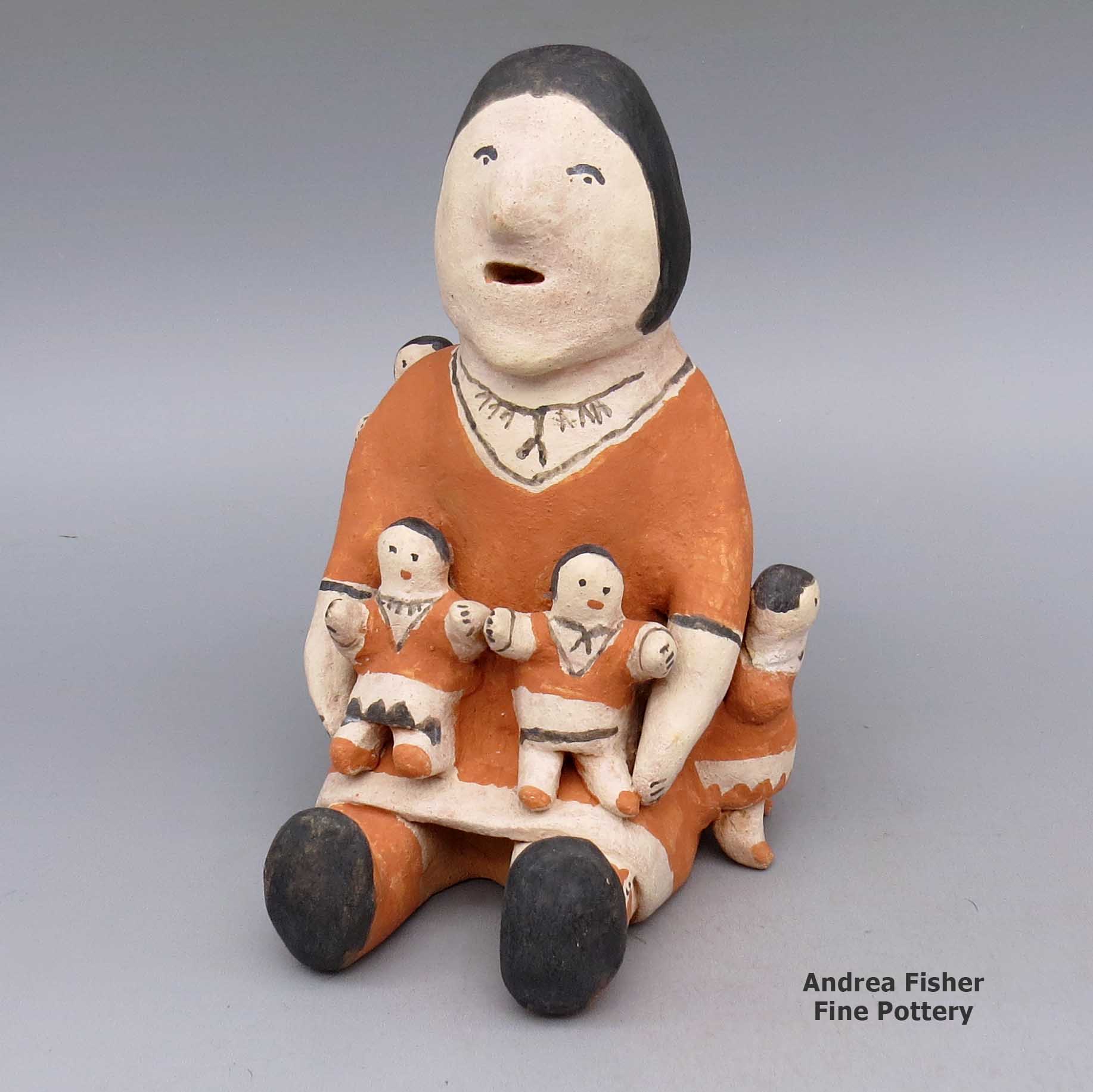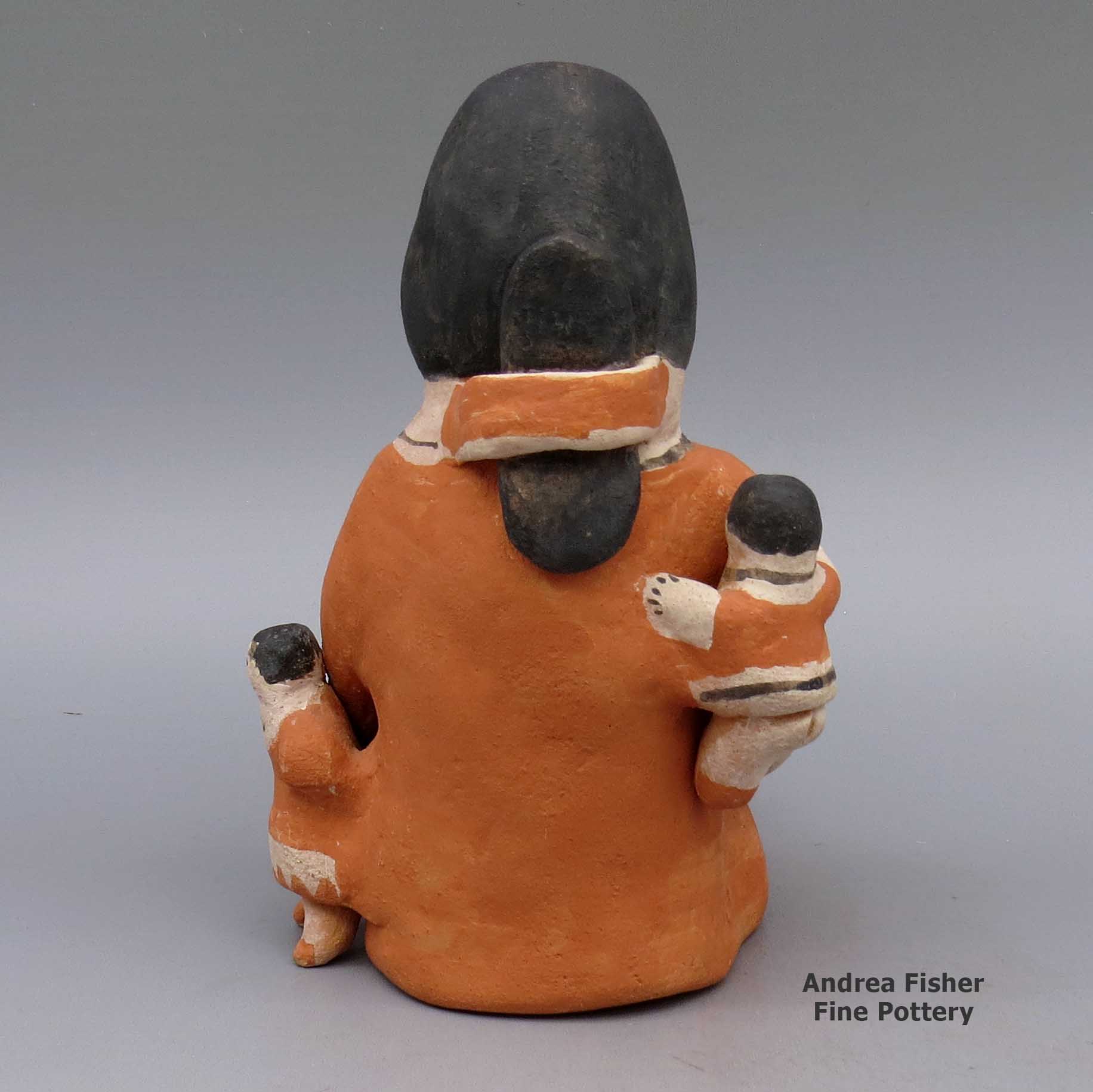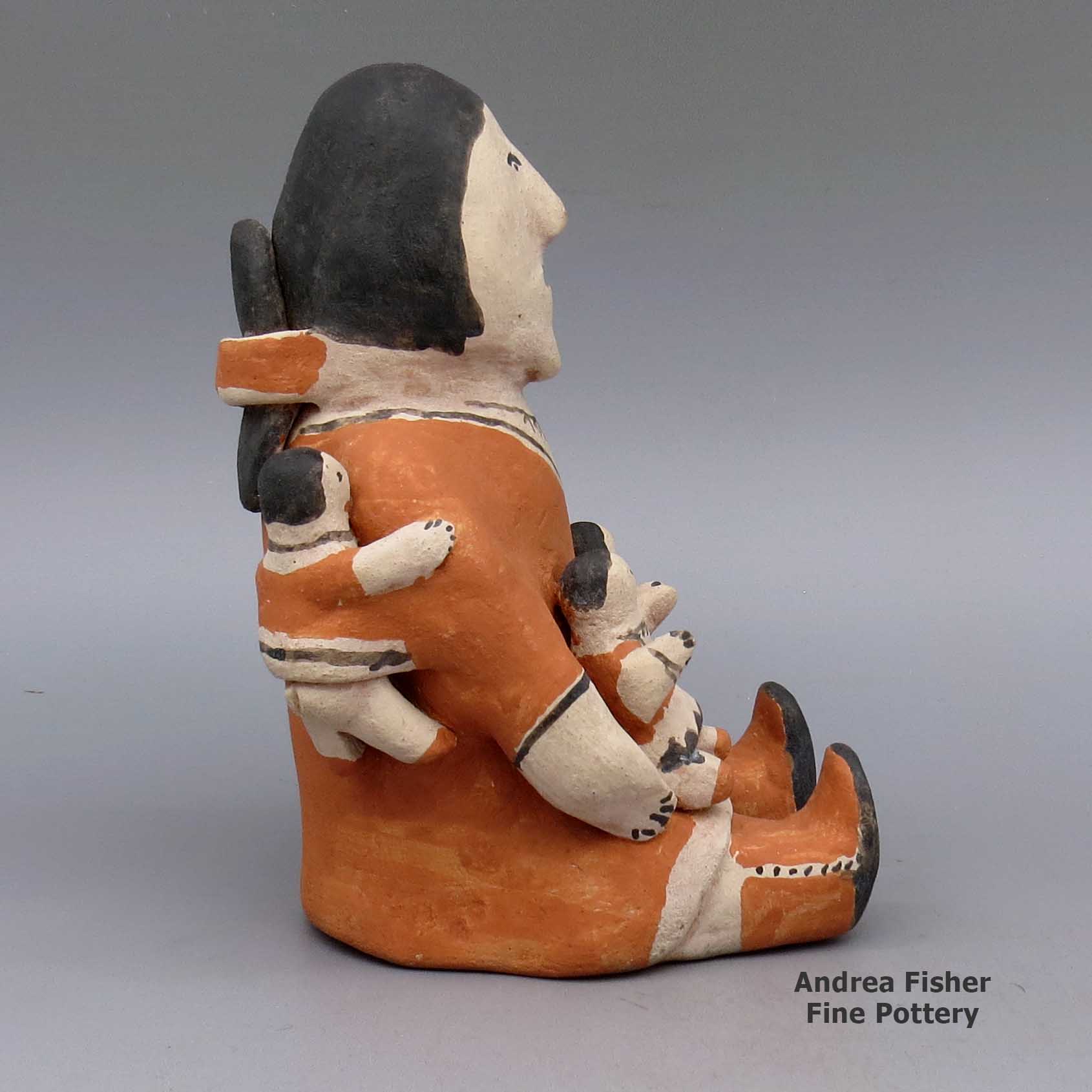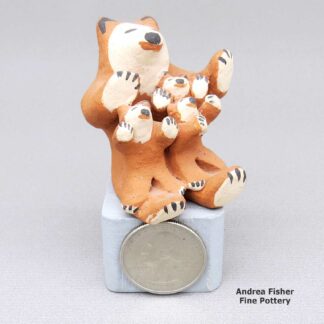| Dimensions | 5 × 4.25 × 6.75 in |
|---|---|
| Condition of Piece | Very good, normal wear |
| Signature | Josephine Arquero Cochiti NM |
Josephine Arquero, lkco2l327: Polychrome storyteller with four children
$450.00
Four children are perched on a polychrome grandmother storyteller figure
In stock
Brand
Arquero, Josephine
Josephine grew up watching her mother fashion the clay figures she became famous for, but Josephine didn't begin to produce pottery herself until she was almost forty. Then in 1980 she earned a Third Prize ribbon at the Santa Fe Indian Market for one of her creations. At that point she said she felt like she was an established, well-known potter.
Josephine liked making figures: priests, cowboys, tourists, mothers and children, storytellers, Nativities and various animals. Early in her career as a potter she made more traditional matte polychrome jars and bowls.
A Short History of Cochiti Pueblo
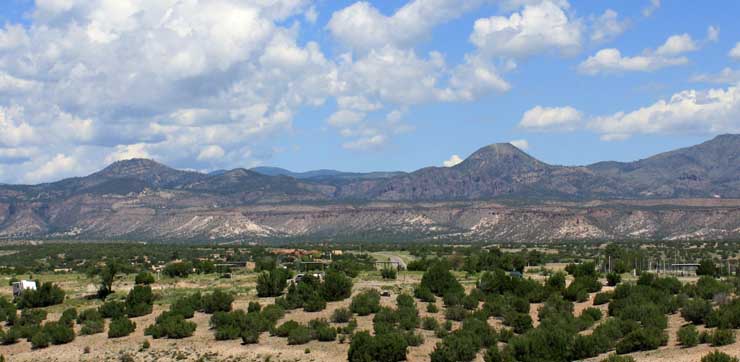
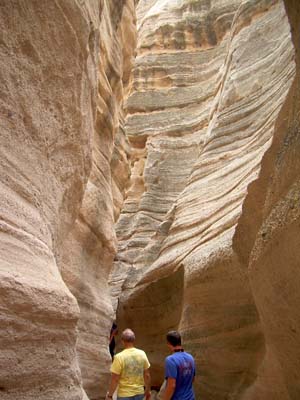
Cochiti Pueblo lies fifteen miles south of Santa Fe along the west bank of the Rio Grande. What is now Bandelier National Monument is the pueblo's most recent ancestral home. They may have relocated to the Bandelier area from the Four Corners region around 1300, and then closer to the Rio Grande in the 1400s in the heart of an even worse drought situation. They merged with people who had been living in the area for hundreds of years before, pushing south until they came up against the countryside of the Tiwa pueblos in the middle Rio Grande.
In those days, the people of Cochiti, Santo Domingo and San Felipe were one Keres-speaking culture. They split into three cultures when some decided to go further down the Rio Grande to settle (San Felipe), and some decided to cross to the eastern side (Santo Domingo). All three speak dialects of Eastern Keres and are considered very conservative.
Cochiti legend says that Clay Old Woman and Clay Old Man came to visit the Cochitis. While all the people watched, Clay Old Woman shaped a pot. Clay Old Man danced too close and kicked the pot. He rolled the clay from the broken pot into a ball, gave a piece to all the women in the village and told them never to forget to make pottery.
Most outsiders who visit Cochiti Pueblo these days do so on the way to or from either the recreation area on Cochiti Lake or Kasha-Katuwe Tent Rocks National Monument.

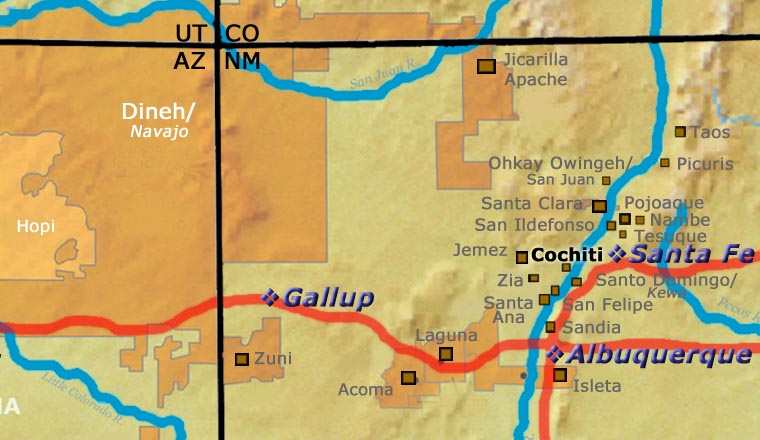
For more info:
Cochiti Pueblo at Wikipedia
Pueblo of Cochiti official website
About the Storyteller
Historically, clay figures have been present in the Pueblo pottery tradition for more than a thousand years. However, figures and effigies were denounced as "works of the devil" by the Spanish missionaries in New Mexico between 1540 and 1820. Before and after that time the art of making figurative sculpture flourished, especially at Cochiti Pueblo. At Cochiti, the forms of animals, birds, caricatures of outsiders and, more recently, images of mothers and grandfathers telling stories and singing to children have multiplied.
The "storyteller" is an important role in the tribes as parents are often too busy working and raising kids to pass on their tribal histories. The Native American people did not develop a written language to record anything for posterity. Some tribes still refuse to create one. The closest thing they had to a written language was recorded on pottery and textiles, in the form of painted designs that decorate that pottery and textiles.
The storyteller's role was to preserve and retell and pass down the oral history of his people in their native language. In most tribes that role was fulfilled by elder men.
The first recorded storyteller figure was created in 1964 by Cochiti Pueblo potter Helen Cordero in memory of her grandfather, Santiago Quintana. She gathered her clay from a secret sacred place on the lands of her pueblo. Then she hand-coiled, hand painted and fired that first storyteller figure the traditional way: in the ground. Helen never used any molds or kilns to make her pottery.
Helen's creation immediately struck a chord throughout all the pueblos as the storyteller is a figure central to all their societies. Most tribes also have the figure of the Singing Maiden in their pantheon and in many cases, the mix of Singing Maiden and Storyteller has blurred some lines in the pottery world.
Today, as many as three hundred potters in thirteen pueblos have created storytellers. Their storytellers are not only men and women but also Santa’s, mudheads, koshares, bears, owls, eagles and other animals, sometimes encumbered with children numbering more than one hundred! Each potter has also customized their storyteller figures to more closely reflect the styles and dress of their own tribes, often even of their own clans.
Santiago Cordero Family Tree - Cochiti Pueblo
Disclaimer: This "family tree" is a best effort on our part to determine who the potters are in this family and arrange them in a generational order. The general information available is questionable so we have tried to show each of these diagrams to living members of each family to get their input and approval, too. This diagram is subject to change should we get better info.
Santiago Cordero was not a potter but he has the distinction of having been married to two of the most influential of Cochiti's potters: Lorenza Cordero and Damacia Cordero.
- Santiago Cordero (1876-) & Lorenza Cordero (c. 1874-)
- Juanita Cordero Arquero (c. 1906-)
- Mary Martin
- Bertha Martin Early (1964-)(former wife of Max Early of Laguna)
- Alan Early
- David Early
- Maria Rose Early
- Bertha Martin Early (1964-)(former wife of Max Early of Laguna)
- Mary Martin
- Felecita Eustace (1927-2016) & Ben Eustace (Zuni)(c. 1920s-)
- Christina Eustace
- James Eustace
- Joseph Eustace (c. 1950s-)
- Linda Eustace
- Nelson Eustace
- Helen Cordero (1915-1994) & Fred Cordero (d. 1994)
- George Cordero (1944-1990) & Kathy Cordero (Hispanic)
- Buffy Cordero (1969-) & Jerry Suina
- Jimmy Cordero & Mary Chalan
- Jimmy Cordero & Lenora Holmes (Hopi)
- Tim Cordero (1963- )
- Toni Suina (c. 1948-) & Delfino Trancosa (1951-)
- Leonard Trujillo (c. 1936-2017) & Mary Trujillo (1937-2021)
- Geraldine Trujillo
- Geraldine Trujillo
- George Cordero (1944-1990) & Kathy Cordero (Hispanic)
- Ramona Cordero
- Santiago Cordero (1876-) & Damacia Cordero (1905-1989)
- Josephine Arquero (1928-)
- Martha Arquero (1944-)
- Gloria Herrera
- Marie Laweka (1931-2002)
- Josephine Laweka (1960-2008)
- Dorothy Trujillo (Jemez/Laguna, married into Cochiti) (Damacia's niece, 1932-1999)
- Judith A. Suina (1960-)
- Cecilia V. Trujillo (1954-)
- Onofre Trujillo Jr. (c. 1969-)
- Norma A. Suina (1944-)
